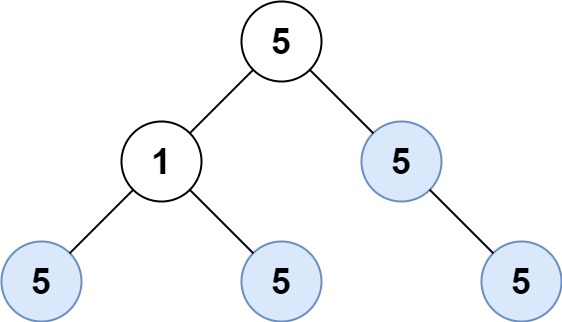250. Count Univalue Subtrees
Medium
Given the root of a binary tree, return the number of uni-value subtrees.
A uni-value subtree means all nodes of the subtree have the same value.
Example 1:

Input: root = [5,1,5,5,5,null,5] Output: 4
Example 2:
Input: root = [] Output: 0
Example 3:
Input: root = [5,5,5,5,5,null,5] Output: 6
Constraints:
- The numbrt of the node in the tree will be in the range
[0, 1000]. -1000 <= Node.val <= 1000
1 2 3 4 5 6 7 8 9 10 11 12 13 14 15 16 17 18 19 20 21 22 23 24 25 26 27 28 | //C++: 4ms /** * Definition for a binary tree node. * struct TreeNode { * int val; * TreeNode *left; * TreeNode *right; * TreeNode(int x) : val(x), left(NULL), right(NULL) {} * }; */ class Solution { public: int countUnivalSubtrees(TreeNode* root) { int cnt = 0; helper(root, cnt); return cnt; } bool helper(TreeNode* root, int &cnt){ if(!root) return true; bool left = helper(root->left, cnt); bool right = helper(root->right, cnt); if(!left || !right) return false; if(root->left && root->left->val!=root->val) return false; if(root->right && root->right->val!=root->val) return false; cnt++; return true; } }; |
1 2 3 4 5 6 7 8 9 10 11 12 13 14 15 16 17 18 19 20 21 22 23 24 25 26 27 28 29 30 31 32 33 34 35 | /** * Definition for a binary tree node. * public class TreeNode { * int val; * TreeNode left; * TreeNode right; * TreeNode() {} * TreeNode(int val) { this.val = val; } * TreeNode(int val, TreeNode left, TreeNode right) { * this.val = val; * this.left = left; * this.right = right; * } * } */ class Solution { int ret = 0; public int countUnivalSubtrees(TreeNode root) { isUni(root); return ret; } boolean isUni(TreeNode root){ if (root==null) return true; boolean left = isUni(root.left); boolean right = isUni(root.right); int v = root.val; if(!left || !right) return false; if(root.left!=null && root.left.val!=v) return false; if(root.right!=null && root.right.val!=v) return false; ret ++; return true; } } |
No comments:
Post a Comment